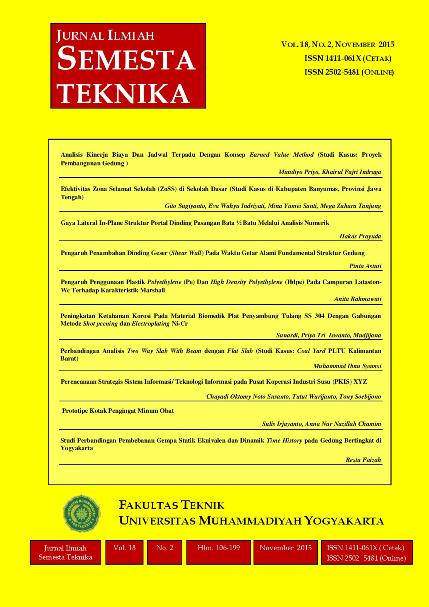Gaya Lateral In-Plane Struktur Portal Dinding Pasangan Bata ½ Batu Melalui Analisis Numerik
DOI:
https://doi.org/10.18196/st.v18i2.1814Keywords:
Brick Masonry Wall, Lateral Force, In-Plane, Numerical AnalysisAbstract
Building construction in Indonesia is categorized as two big classes; there are engineered building and non-engineered building. Non-engineered building is very susceptible to the lateral load such as an earthquake, either medium earthquake or massive earthquake that causing sudden collapse so that the research of mitigation building strength needs to be done which is rely on the strength of brick masonry (non-engineered building) that can be predicted through measuring micro vibration at the bottom and the top of the brick masonry wall surface. The aims of this research is to find out the effect of ½ stone brick masonry in its contribution to the rigidity of simple portal structure by using loading in-plane lateral system. Loading analysis result at the plastic limit is 95, 524 kN or only 86,89% of the maximum load, meanwhile lateral deviation at the plastic limit is 7,506 cm or 27,51% of maximum lateral deviation. Besides, The rigidity of ½ stone brick masonry wall is 12,72 kN/cm.
Downloads
Published
How to Cite
Issue
Section
License
Semesta Teknika is licensed under a Creative Commons Attribution 4.0 International License.
Authors who publish with this journal agree to the following terms:
- Authors retain copyright and grant the journal right of first publication with the work simultaneously licensed under a Creative Commons Attribution License that allows others to share the work with an acknowledgement of the work's authorship and initial publication in this journal.
- Authors are able to enter into separate, additional contractual arrangements for the non-exclusive distribution of the journal's published version of the work (e.g., post it to an institutional repository or publish it in a book), with an acknowledgement of its initial publication in this journal.
- Authors are permitted and encouraged to post their work online (e.g., in institutional repositories or on their website) prior to and during the submission process, as it can lead to productive exchanges, as well as earlier and greater citation of published work (See The Effect of Open Access).









